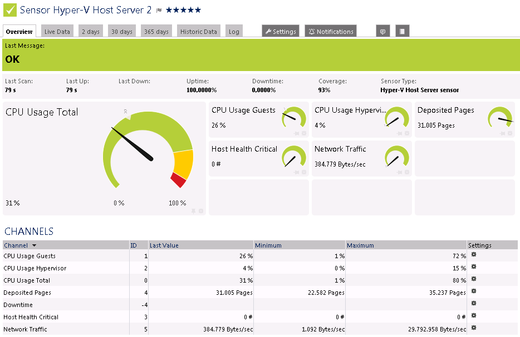In the last few years the tasks of system administrators have changed quite a lot. Today networks are more than their physical layout of servers, routers, and switches reveals. With virtualization and cloud applications also the task of maintaining the network has grown more complex.
With this week's featured Hyper-V Host Server sensor you can monitor a Microsoft Hyper-V host server via Windows Performance Counters or Windows Management Instrumentation (WMI), as configured in the "Windows Compatibility Options" of the parent device. The sensor displays the following values, giving you a good impression of the Hyper-V host server's condition:
- CPU usage in percent of guests, hypervisor, and total,
- Host health critical values,
- The number of deposited pages, and
- Network traffic.
If you're working with virtual environments, your users need be able to rely on a functioning infrastructure as much as if they were using physical workstations. Although virtualization is a big, complex field, knowing the host servers are running smoothly is an important first step.
For more detailed information on the Hyper-V Host Server sensor please have a look at the PRTG manual. Why don't you give it a try?
All Sensors of the Week
You have missed other articles of our "Sensors of the Week" blog series? Just take a look at the last 10 sensors:
- WMI Security Center sensor
- SNMP Cisco System Health sensor
- WMI Service sensor
- SNMP RMON sensor
- Passive Application Performance sensor
- Hyper-V Host Server sensor
- SSH Script sensor
- QoS (Quality of Service) Round Trip sensor
- Windows Last Update sensor
- NetFlow V5 sensor
Subscribe to our RSS feed to always stay up to date on new articles!
 Published by
Published by 













